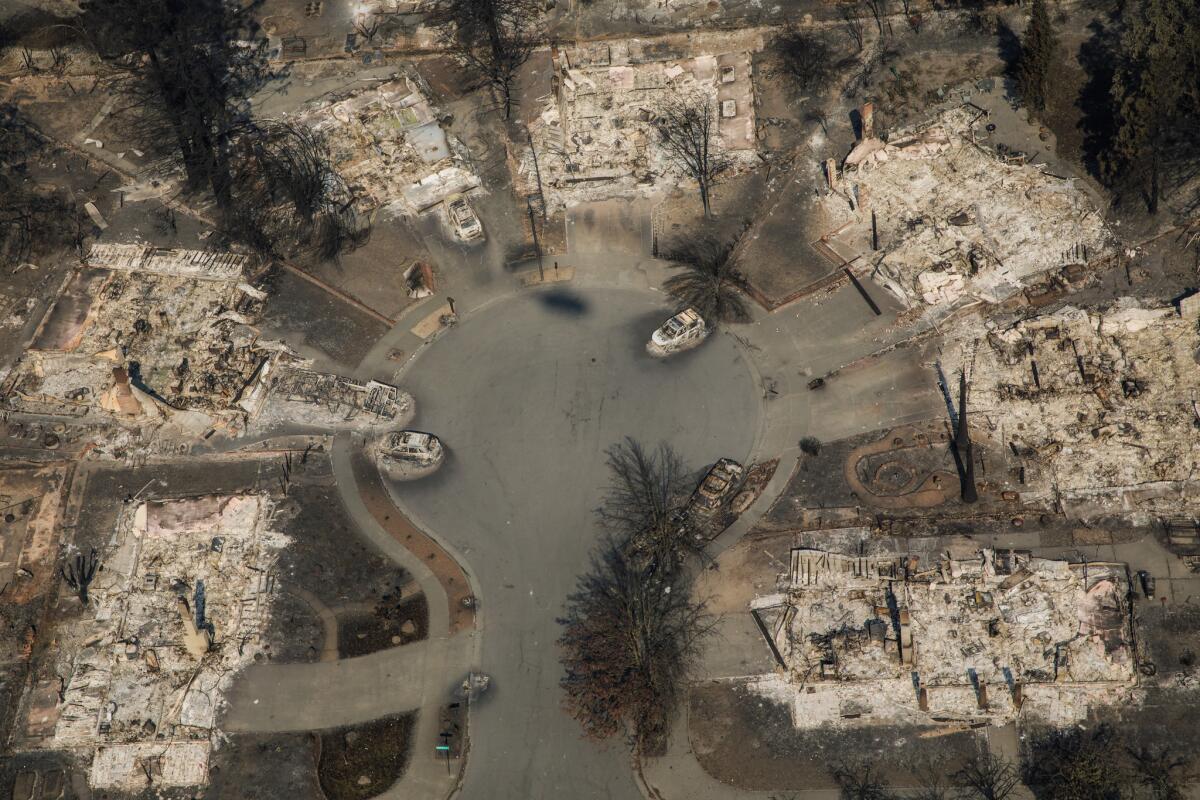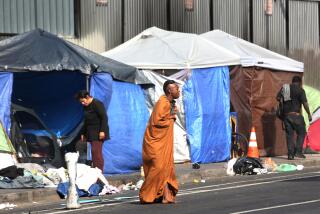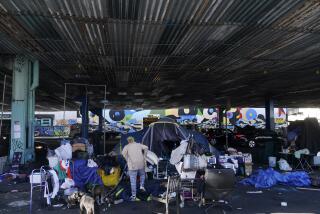California wine country wildfire victims still waiting for $200 million in federal funds

SACRAMENTO — Nearly two years after wildfires ripped through Northern California’s wine country, those who suffered losses from the blazes have yet to receive more than $200 million in federal funding intended to rebuild and help prevent future disasters in the state.
The money, authorized by Congress in February 2018, would help finance reconstruction and build new apartments for low-income homeowners and renters affected by the wildfires and allow local governments and the state to prepare for new emergencies. And help could soon be on the way: In July, the federal Department of Housing and Urban Development signed off on California’s plan to spend $124 million of its allocation, and a deal is expected to be finalized this month.
But the sluggish pace of the approval process, driven by problems within federal and state bureaucracies, has exasperated Sonoma County and Santa Rosa leaders who are counting on the money to help restore the community. County and city officials have met with HUD five times since the fires pleading for the funds, said David Rabbitt, the chairman of the Sonoma County Board of Supervisors.
“There is a real urgency,” Rabbitt said. “And bureaucracy and urgency most of the times don’t align very well. That’s the biggest frustration.”
The Trump administration has been slow to approve the relief dollars nationwide, arguing that the substantial funding approved by Congress requires appropriate oversight to ensure the money isn’t misspent. In California, HUD officials have pointed to a recent report that determined the state’s handling of federal dollars for anti-poverty and anti-foreclosure programs and prior disaster relief efforts “posed an unacceptably high risk” of mismanagement.
“Recovery can never occur quickly enough, especially for those who have lost their homes and are desperate to rebuild,” said Frank McNally, deputy director of HUD’s disaster recovery division, in response to written questions from The Times. “That said, these dollars must support recovery which requires the state to manage these funds in a manner that accomplishes that.”
U.S. Department of Housing and Urban Development report on California Department of Housing and Community Development’s oversight of federal grants.
Meanwhile, congressional watchdogs have contended that the federal agency has seemed overwhelmed by the scale of the disaster relief programs, contributing to the spending delays. Of the $35.8 billion Congress has approved for disasters that occurred in 2017, including Hurricane Maria in Puerto Rico and Hurricane Harvey in Texas, and some prior events, HUD so far has agreed to give out just $7.6 billion, or about one-fifth of the total.
More than 4,500 homes were destroyed and 22 people died in the Tubbs fire that began in Napa County and spread through Sonoma County in October 2017. Federal funding for wine country to rebuild was included in a budget deal negotiated soon after between President Trump and Congress. Some of the California money would also go toward relief efforts for 2017 wildfires and mudslides in Ventura, Mendocino, Yuba, Lake, Santa Barbara, Butte, Los Angeles, Nevada and San Diego counties.
Around the time of the Tubbs fire, HUD investigators were looking into California’s Department of Housing and Community Development’s oversight of federal grants. They found that the state had been slow to distribute tens of millions of dollars issued by the federal government since 2005, primarily through the Community Development Block Grant program, the federal agency said in a report released in March 2018.
The report also found that money the state housing department had allocated was done with little supervision. For example, HUD learned that the state housing department had not made sure that homes subsidized with federal dollars were free of lead-based paint, nor had it ensured that documents had been filed to reserve homes for low-income residents. California housing officials also were found to have conducted only a handful of on-site visits to monitor spending since 2014 and hadn’t completed a required audit of the federal programs in more than four years.
These issues, HUD reviewers wrote in the report, “amount to a systemic failure that prevents the state from using program funds in accordance with program requirements, and creates significant risks of fraud, waste and mismanagement of funds.” California housing officials did not dispute HUD’s findings.
Ben Metcalf, the director of California’s housing department, said oversight of federal housing dollars lapsed during the state’s financial crisis a decade ago when budget cuts gutted the department. Metcalf said the department decided to focus on monitoring the subsidies it gave developers rather than the federal dollars, which were primarily allocated to local governments.
“That’s not ideal. That’s not what HUD would want to hear. But it was the cold calculation of: What do you do when you need to stretch your resources?” Metcalf said.
Since the HUD report was released last spring, the state housing department has overhauled how it handles federal money to address poverty, including purchasing a new computer system to better track grants, Metcalf said.
But the problems identified in the report delayed the approval of the 2017 relief money, McNally said.
“While the state is making significant progress to improve its financial controls, we have a responsibility to taxpayers to ensure these critically needed recovery dollars are properly managed,” McNally said.
Last month, HUD officials told the state housing department it had implemented an adequate oversight program and agreed to release $124 million for long-term recovery efforts for the 2017 disasters. The state plans to finalize the agreement this month, allowing for the money to begin helping victims soon after.
Trump and state officials in California have fought over numerous issues, including the environment and immigration, since the president took office in 2017. On multiple occasions, Trump has threatened to withhold California’s disaster relief funding as punishment for state policies. But Metcalf and McNally both say these disputes did not hold up the state’s allocation for the 2017 wildfires.
It’s not just California where the 2017 disaster relief money has failed to reach victims, generating significant frustration across the country.
Congress approved multiple rounds of funding for disasters that occurred in 2017, with the first $7.4 billion marked to assist repairs from hurricane damage in Puerto Rico, Texas, the U.S. Virgin Islands and Florida. Though HUD has approved spending plans for those areas, a report published this spring by the United States Government Accountability Office found that those governments had allocated less than 1% of that money as of January. Of an additional $28.4 billion authorized by Congress for the 2017 disasters and some events prior — including $212 million for California — HUD has reached agreements only on the spending of $196 million for Florida and Georgia to clean up after storms and tornadoes in those states.
Some of the money could be tied up for a long time. About half the total funding, or $16 billion, is supposed to go toward efforts to prevent damage in future disasters across the country. In California’s allocation, the remaining $88 million is dedicated to this program.
This year, HUD Secretary Ben Carson told federal lawmakers that the department aimed to publish the framework for how that prevention money is supposed to be spent — an interim step before state and local governments could receive the cash — by May 1. But that still hasn’t happened, and HUD officials have said they’re awaiting review from the White House. In the latest round of disaster relief funding passed in June, Trump agreed to post the regulations by early September.
The Government Accountability Office report said that HUD lacked a plan to ensure the disaster relief money was allocated quickly, didn’t have the staff to oversee the funding and struggled with shifting requirements for emergency programs over the years.
HUD officials, however, have contended that the unprecedented amount of funding related to the 2017 disasters requires significant oversight. Congress has approved about $20 billion through this program for Puerto Rico’s recovery from Hurricane Maria. Last month, the FBI arrested multiple high-ranking officials there following allegations that they steered federal money to politically connected contractors.
“This is an unprecedented investment, and since Puerto Rico has a history of fiscal malfeasance, we are putting additional financial controls in place to ensure this disaster recovery money is spent properly,” Carson said when approving one of the island’s plans in the spring.
Nevertheless, the slow pace has outraged lawmakers. In March, U.S. Sen. John Cornyn (R-Texas), typically an ally of the president, blasted Trump’s budget staff for holding up the spending. Texas has gotten $5 billion from HUD but is awaiting approval for nearly $5 billion more to clean up from Hurricane Harvey and fortify against future disasters.
“The disregard of those who are struggling to rebuild and prepare for future storms by the bureaucrats is appalling,” Cornyn said on the Senate floor.
Back in California, wildfire victims are awaiting assistance. Sonoma County is counting on the federal dollars to help subsidize at least seven new low-income housing projects with additional developments planned in Santa Rosa.
The Tubbs fire destroyed a mobile home park in the city, scattering residents who lived in 160 trailers. A new low-income complex with 160 homes is planned for the site, with former residents getting first priority to move in.
Dorothy Ervin, 79, was a live-in caretaker for her friend Emma Landi, 72, in the park, and the pair escaped the night of the fire with only their dog and their medication. They’re staying in a nearby mobile home park for senior citizens and have tried in vain to locate permanent housing amid the persistent affordability challenges affecting the state.
“We’re in a place right now that’s temporary,” Ervin said. “We’re going to have to find a place, and it’s very hard to find a place out here.”
Rabbitt, the Sonoma County supervisor, said the upcoming second anniversary of the fires worries him. Temporary housing allowances run out after two years for many homeowner insurance policies, and Rabbitt fears that the region will see another wave of people who will be displaced unless they receive further assistance.
“Time is of the essence,” he said. “The quicker that they can get the money in the community, the better off we would be.”
More to Read
Sign up for Essential California
The most important California stories and recommendations in your inbox every morning.
You may occasionally receive promotional content from the Los Angeles Times.











